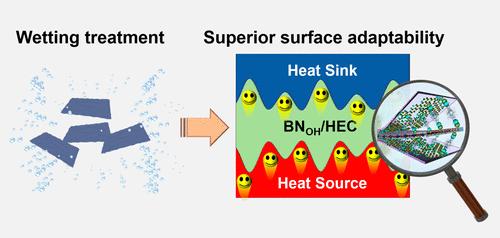Multiscale Modeling of Heat Conduction in a Hydroxyethyl Cellulose/Boron Nitride Composite Realizing Ultrahigh Thermal Conductivity via a “Moisture-Activated” Strategy
IF 8.3
2区 材料科学
Q1 MATERIALS SCIENCE, MULTIDISCIPLINARY
引用次数: 0
Abstract
Polymer-based thermally conductive composites are widely used in microelectronics for heat dissipation and packaging, for which the filler arrangement and the filler/matrix interfacial thermal resistance (ITR) are key factors limiting superior thermal conduction realization. This work reveals the effects of filler modification and orientation on thermal duction in the boron nitride (BN)/hydroxyethyl cellulose (HEC) through multiscale simulation approaches. Nonequilibrium molecular dynamics (NEMD) identifies that the thermal conductivity of the BN molecule is not size-dependent and proves that thermal resistance is dramatically reduced after hydroxylation modification (BNOH). Finite element simulation (FEM) reveals that maintaining a proper tilt of BN may improve both the cross-plane and in-plane thermal conductivity of the composite. Experimentally, BNOH/HEC composites with high self-viscosity are prepared via a “moisture-activated” strategy, for which the introduction of BNOH and wet hot pressing contribute to the thermal resistance reduction and filler orientation, respectively. The in-plane thermal conductivity reaches 30.64 W/mK with a cross-plane thermal conductivity of 5.06 W/mK. The films show good adaptability to surface morphology with the thermal resistance decreasing to 1.42 K·cm2/W. Practical thermal management demonstrates that the incorporation of BNOH/HEC facilitates a 15.05 °C reduction of the LED Al substrate compared to the common composite film.

通过“湿活化”策略实现超高导热性的羟乙基纤维素/氮化硼复合材料热传导的多尺度建模
聚合物基导热复合材料广泛应用于微电子散热和封装领域,填料的排列方式和填料/基体界面热阻(ITR)是制约其导热性能的关键因素。本研究通过多尺度模拟方法揭示了填料改性和取向对氮化硼(BN)/羟乙基纤维素(HEC)热传导的影响。非平衡分子动力学(NEMD)发现BN分子的热导率不依赖于尺寸,并证明羟基化修饰(BNOH)后热阻显着降低。有限元模拟结果表明,保持BN的适当倾斜可以提高复合材料的面内和跨面导热系数。实验中,通过“湿活化”策略制备了具有高自粘度的BNOH/HEC复合材料,其中BNOH的引入和湿热压分别有助于降低热阻和填料取向。平面内导热系数为30.64 W/mK,平面间导热系数为5.06 W/mK。薄膜对表面形貌具有良好的适应性,热阻降至1.42 K·cm2/W。实际热管理表明,与普通复合薄膜相比,BNOH/HEC的掺入有助于LED Al衬底降低15.05°C。
本文章由计算机程序翻译,如有差异,请以英文原文为准。
求助全文
约1分钟内获得全文
求助全文
来源期刊

ACS Applied Materials & Interfaces
工程技术-材料科学:综合
CiteScore
16.00
自引率
6.30%
发文量
4978
审稿时长
1.8 months
期刊介绍:
ACS Applied Materials & Interfaces is a leading interdisciplinary journal that brings together chemists, engineers, physicists, and biologists to explore the development and utilization of newly-discovered materials and interfacial processes for specific applications. Our journal has experienced remarkable growth since its establishment in 2009, both in terms of the number of articles published and the impact of the research showcased. We are proud to foster a truly global community, with the majority of published articles originating from outside the United States, reflecting the rapid growth of applied research worldwide.
 求助内容:
求助内容: 应助结果提醒方式:
应助结果提醒方式:


